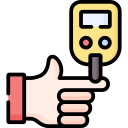Call your senior or the diabetes on call team if you aren't sure what to do, or if there is a clinical concern.
If patient is using an insulin pump (continuous subcutaneous insulin infusion) please refer to Insulin Pump section
- Ketones can develop if insulin deficient due to insulin omission or increased requirements due to intercurrent illness
- If ketones accumulate, there is a risk of developing diabetic ketoacidosis (DKA)
- Capillary ketones should be checked if capillary blood glucose (CBG) is >14mmol/L.
- Much less likely to develop DKA unless they have a severe intercurrent illness or are on an SGLT2 inhibitors (SGLT2i) ("-gliflozins")
- There is a small risk of euglycaemic DKA with SGLT2i
- SGLT2i should be stopped if patients are fasting, have a reduced oral intake or are unwell with an acute illness.
- Other reasons for raised ketones include starvation, alcohol, sepsis and a ketogenic diet.
- Always consider DKA but raised ketones can simply be a sign of acute illness and highlights the need for an urgent medical review.
Ketones < 0.6
- Considered normal
- No extra intervention needed
Ketones 0.6 – 1.4
- Slightly raised
- Encourage to drink sugar free fluids
- Consider a correction dose of short acting insulin to correct hyperglycaemia
- Repeat CBG and ketones in 2hrs
- If rising, contact diabetes on call in hours or senior out of hours
Ketones 1.5 – 2.9
- Raised
- Encourage to drink sugar free fluids
- Give an extra correction dose of short acting insulin at 10% of their total daily dose (TDD*) of insulin to correct hyperglycaemia
- Repeat CBG and ketones in 2hrs
- If rising, contact diabetes on call in hours or senior out of hours
Ketones > 3
- Very raised
- Check venous blood gas - if acidotic, treat as DKA
- If not acidotic
- Encourage to drink sugar free fluids
- Give an extra correction dose of short acting insulin at 20% of their TDD* of insulin to correct hyperglycaemia
- Repeat CBG and ketones in 2hrs
- If rising, contact diabetes on call in hours or senior out of hours
- *Total daily dose (TDD) of insulin can be calculated by adding up all the long and short acting insulin a person takes in a 24hr period
- Avoid correction doses closer than 2 hours apart as there is a risk of insulin stacking and hypoglycaemia
Call your senior or the diabetes on call team if you aren't sure what to do, or if there is a clinical concern
